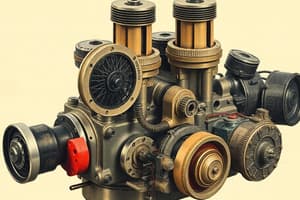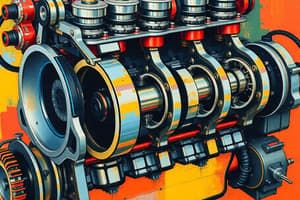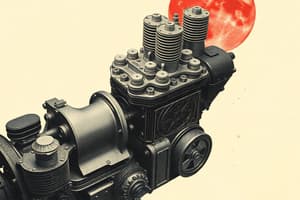Podcast
Questions and Answers
What is a characteristic feature of a two-stroke engine compared to a four-stroke engine?
What is a characteristic feature of a two-stroke engine compared to a four-stroke engine?
- It completes the power cycle in one crankshaft revolution. (correct)
- It produces more power strokes per cycle.
- It requires more components to operate.
- It has a longer operational cycle.
During which stroke does the piston create a highly combustible environment for ignition?
During which stroke does the piston create a highly combustible environment for ignition?
- Intake stroke
- Power stroke
- Exhaust stroke
- Compression stroke (correct)
What occurs during the exhaust stroke of the engine cycle?
What occurs during the exhaust stroke of the engine cycle?
- The piston expels burned gases from the cylinder. (correct)
- The intake valve opens to let in new air and fuel.
- The connecting rod connects the piston to the crankshaft.
- The spark plug ignites the air-fuel mixture.
What is the primary function of the crankshaft in an engine?
What is the primary function of the crankshaft in an engine?
What issue can arise if the step of removing burned gases from the cylinder is skipped?
What issue can arise if the step of removing burned gases from the cylinder is skipped?
In what application are two-stroke engines commonly favored over four-stroke engines?
In what application are two-stroke engines commonly favored over four-stroke engines?
What is the function of the piston during the intake stroke?
What is the function of the piston during the intake stroke?
How many total strokes are needed in a four-stroke engine for one complete power cycle?
How many total strokes are needed in a four-stroke engine for one complete power cycle?
What sequence of strokes occurs in a four-stroke engine?
What sequence of strokes occurs in a four-stroke engine?
What happens during the exhaust stroke of a four-stroke engine?
What happens during the exhaust stroke of a four-stroke engine?
How does a malfunctioning intake valve affect the engine cycle?
How does a malfunctioning intake valve affect the engine cycle?
What is the role of timing in the exhaust valve operation?
What is the role of timing in the exhaust valve operation?
What could result from improper execution of the exhaust stroke?
What could result from improper execution of the exhaust stroke?
Why is a four-stroke engine considered efficient?
Why is a four-stroke engine considered efficient?
What occurs if residual exhaust gases enter a cylinder during the intake stroke?
What occurs if residual exhaust gases enter a cylinder during the intake stroke?
What is the function of the piston during the intake stroke?
What is the function of the piston during the intake stroke?
What occurs during the Intake Stroke of the Otto Cycle?
What occurs during the Intake Stroke of the Otto Cycle?
What is the function of the Exhaust Stroke?
What is the function of the Exhaust Stroke?
How does a malfunctioning intake valve affect engine performance?
How does a malfunctioning intake valve affect engine performance?
During the Compression Stroke, what happens to the volume and pressure in the cylinder?
During the Compression Stroke, what happens to the volume and pressure in the cylinder?
What distinguishes a petrol engine's ignition from a diesel engine's?
What distinguishes a petrol engine's ignition from a diesel engine's?
What is the significance of the Bottom Dead Center (BDC) in the engine cycle?
What is the significance of the Bottom Dead Center (BDC) in the engine cycle?
What is the function of the spark plug in petrol engines?
What is the function of the spark plug in petrol engines?
What is meant by the compression ratio in an engine?
What is meant by the compression ratio in an engine?
What is the primary function of the spark plug in the Otto cycle?
What is the primary function of the spark plug in the Otto cycle?
What distinguishes diesel engines from petrol engines regarding compression ratios?
What distinguishes diesel engines from petrol engines regarding compression ratios?
Which of the following statements about fuel efficiency is correct?
Which of the following statements about fuel efficiency is correct?
During which stroke does the spark plug ignite the air-fuel mixture in petrol engines?
During which stroke does the spark plug ignite the air-fuel mixture in petrol engines?
What is one advantage of diesel engines over petrol engines?
What is one advantage of diesel engines over petrol engines?
How do diesel engines achieve self-ignition?
How do diesel engines achieve self-ignition?
What happens to the pressure within the cylinder during combustion?
What happens to the pressure within the cylinder during combustion?
Which of the following characteristics is more prominent in petrol engines compared to diesel engines?
Which of the following characteristics is more prominent in petrol engines compared to diesel engines?
What method do diesel engines use to ignite the air-fuel mixture?
What method do diesel engines use to ignite the air-fuel mixture?
What is the compression ratio of the 2015 VW Golf TDI?
What is the compression ratio of the 2015 VW Golf TDI?
Which component primarily increases fuel supply in diesel engines?
Which component primarily increases fuel supply in diesel engines?
How do diesel engines compare to petrol engines in terms of fuel efficiency?
How do diesel engines compare to petrol engines in terms of fuel efficiency?
Which is a characteristic of the power stroke in diesel engines?
Which is a characteristic of the power stroke in diesel engines?
What distinguishes the way petrol engines manage air intake compared to diesel engines?
What distinguishes the way petrol engines manage air intake compared to diesel engines?
At what RPM do diesel engines typically produce more torque?
At what RPM do diesel engines typically produce more torque?
What happens during the compression stroke of a diesel engine?
What happens during the compression stroke of a diesel engine?
Study Notes
Four-Stroke Engine Basics
- Four Strokes: Intake, Compression, Power, Exhaust
- Intake Stroke: Piston moves down; intake valve opens; air-fuel mixture enters
- Compression Stroke: Piston moves up; air-fuel mixture is compressed; creates a combustible environment
- Power Stroke: Spark plug ignites the mixture; combustion drives the piston down; generates power
- Exhaust Stroke: Piston moves up; opens exhaust valve; pushes burnt gases out
Intake Valve Malfunctions
- Malfunction Prevents Air-Fuel Mixture Entry: Disrupts suction and causes the engine to stall
- Incomplete Combustion: Can result in engine misfiring or decreased power
- Exhaust Valve Opens: May expel unburnt fuel, making the engine more inefficient
Exhaust Stroke Importance
- Residual Exhaust: Can dilute fresh air-fuel mixture reducing engine efficiency
- Designed Valve Timing: Opens before BDC, allowing pressure to assist in expulsion
Two-Stroke vs Four-Stroke Engines
- Two-Stroke: Single revolution, two strokes, completes cycle quickly; lighter and more compact
- Four-Stroke: Two revolutions, four strokes, more complex operation, efficient and low emissions
- Four-Stroke Examples: cars, motorcycles
- Two-Stroke Examples: motorcycles, chainsaws
Key Components of a Four-Stroke Engine
- Piston: Moves up and down in cylinder
- Connecting Rod: Links piston to crankshaft
- Crankshaft: Converts linear motion of piston to rotational motion
Petrol vs Diesel Engines
- Operation: Both use four-stroke cycle, but ignition methods differ
- Spark Plug Ignition: Petrol engines ignite the air-fuel mixture with a spark plug
- Self-Ignition: Diesel engines use high compression to ignite the air-fuel mixture
- Compression Ratio: Diesel engines have higher compression ratios, typically 16.2:1 compared to petrol 9.6:1
- Energy Content: Diesel has 15% more energy per volume than petrol
- Efficiency: Diesel engines are more efficient due to high compression ratio; higher thermal efficiency due to the way combustion happens
Diesel Engine Components
- Throttle Mechanism: Diesel engines lack a throttle body; pressing the accelerator increases fuel supply
- Fuel injectors: Introduce atomized diesel fuel into the high-pressure, high-temperature air
Diesel Cycle
- Intake Stroke: Intake valve opens; piston descends and draws in air
- Compression Stroke: Intake valve closes; piston ascends; compresses air; temperature rises
- Power Stroke: Fuel injected into highly compressed air; combustion forces piston down; produces power
- Exhaust Stroke: Piston ascends; expels burnt gases through exhaust valve
Studying That Suits You
Use AI to generate personalized quizzes and flashcards to suit your learning preferences.
Related Documents
Description
Explore the essential components and processes of a four-stroke engine. This quiz covers the four strokes, potential malfunctions related to the intake valve, and the significance of the exhaust stroke. Dive deep into understanding how these elements work together for optimal engine performance.




